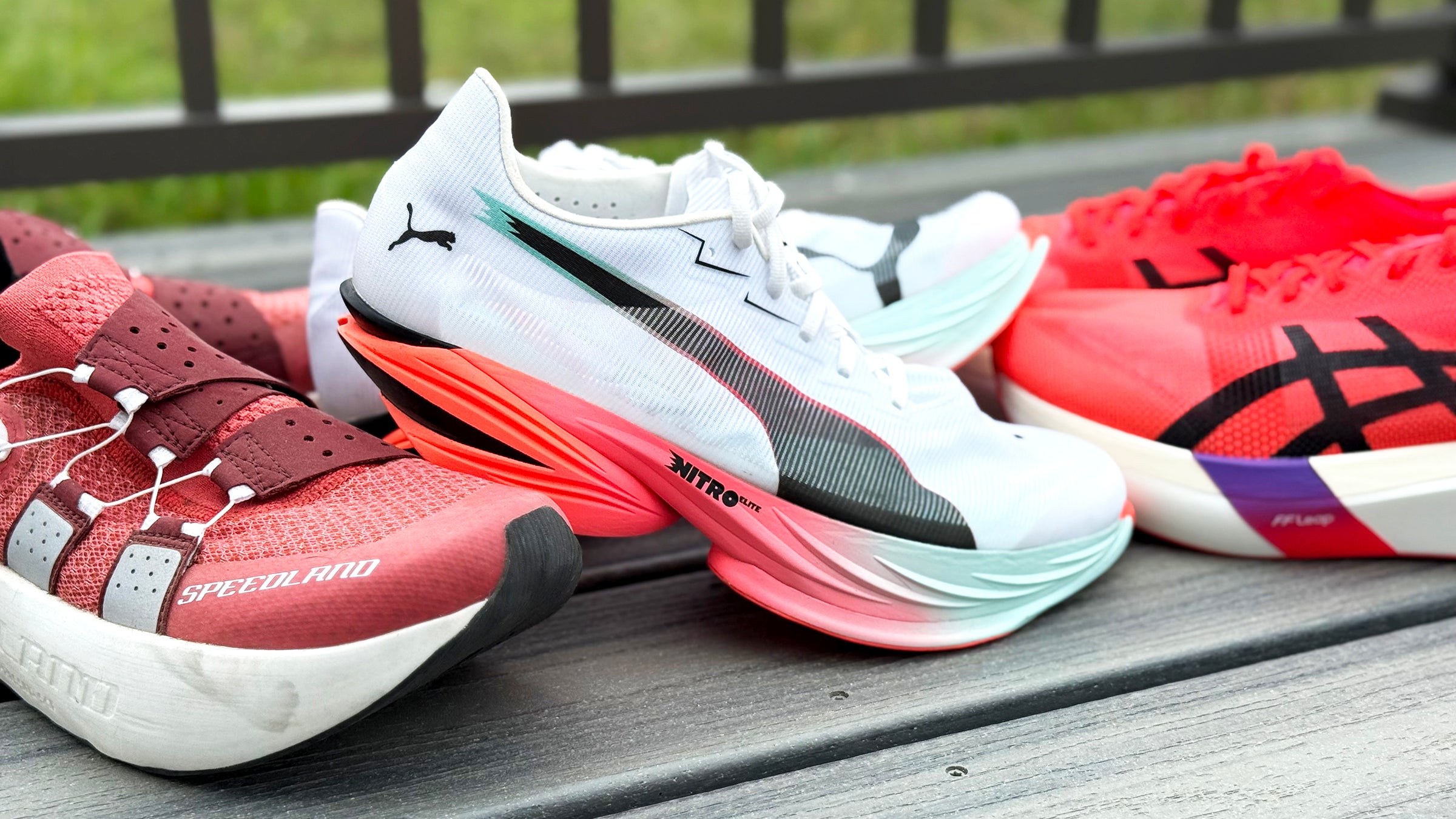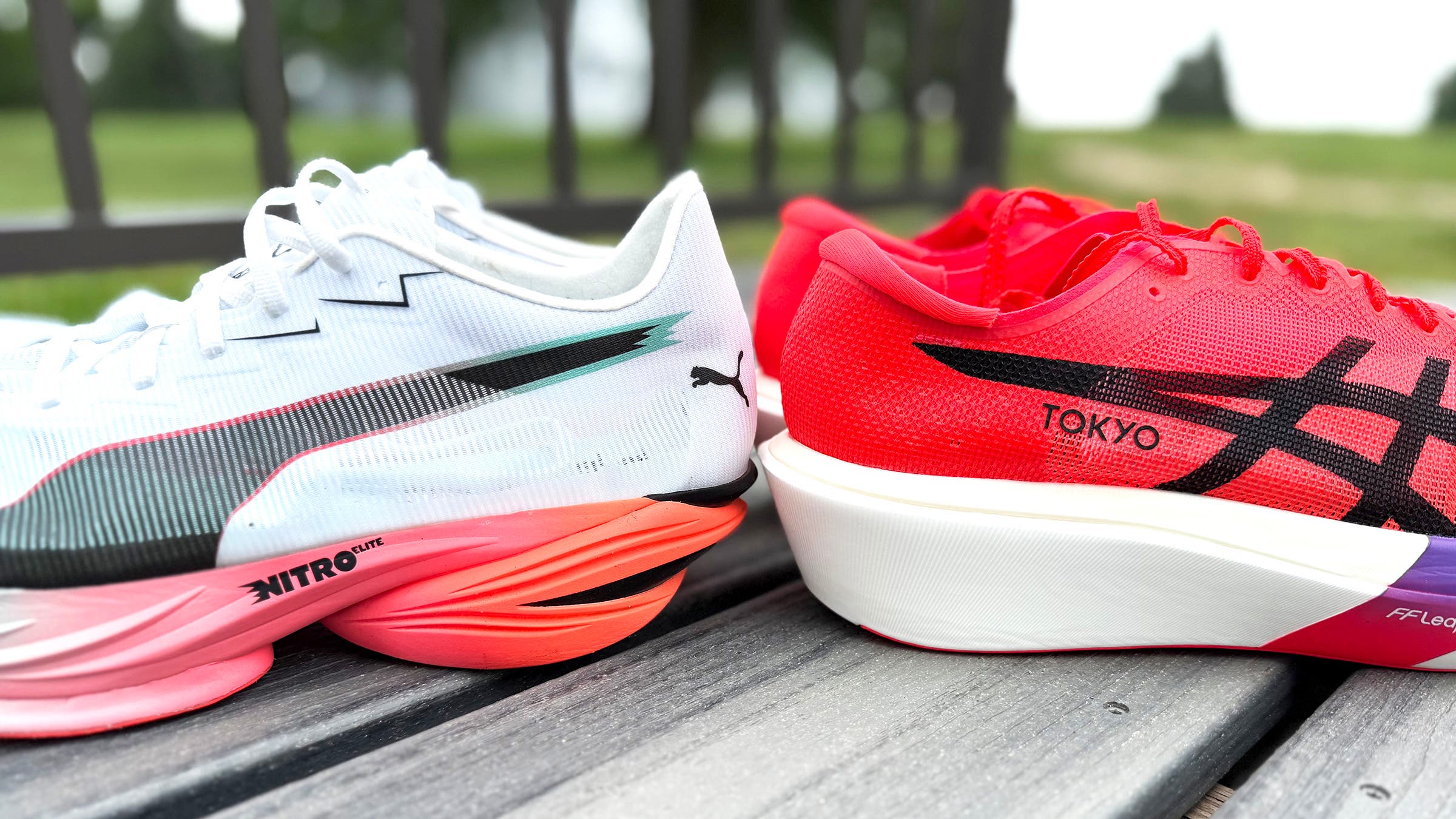The New Foam That Could Propel You to a Marathon PR

(Photo: 101 Degrees West)
We are arguably living through the most pivotal period in the history of running shoes. Never before has picking a race-day shoe had as significant an impact on performance as it does today. A growing body of research confirms this: Studies show that modern super shoes can improve running economy by up to 4 percent, or more, translating to significant time savings in races.
Over the past nine years, shoe technology has evolved at a lightning pace. High-rebound foams, new gas-infusing processes, carbon fiber plates, and finely-tuned geometries have turned running shoes into performance tools as critical for a race-day edge as the details of a racer’s training plan.
How Running Shoe Foam Evolved
Early running shoes were little more than slabs of heavy rubber, offering scant cushioning or shock absorption. That changed in the early 1970s when the brand Tiger, with help from Bill Bowerman (who would later co-found Nike), added a softer rubber layer underfoot with extra padding in the heel. Known as the midsole, this innovation revolutionized running shoes and sparked a widespread demand among runners for more cushioning.
As runners began craving greater comfort, Jerry Turner, then president of Brooks, searched for a better cushioning solution. Through discussions with their rubber supplier, he discovered EVA (ethylene vinyl acetate), a lightweight, responsive, durable foam. The 1975 Brooks Villanova was the first shoe to use EVA as the midsole. It quickly gained popularity, prompting other brands to follow.
For the next four decades, EVA dominated midsoles, with a few outliers made out of more stable polyurethane (PU). That changed in 2013 when Adidas launched a foam made from expanded thermoplastic polyurethane (TPU) beads called Boost.
Boost delivered a softer feel, a more powerful bounce back, and greater durability than EVA. It combined two properties that had previously been mutually exclusive: cushioning and responsiveness. Before Boost, shoes were either soft or fast, but never both. Its only downside was that it weighed more than EVA. Still, Boost marked the first serious challenge to EVA’s long reign, introduced the term “energy return” into shoe vocabulary, and opened the doors for the next generation of midsole foams.
The Birth of a Super Foam
In 2017, Nike launched the Vaporfly 4%, a shoe it claimed could improve running economy by 4 percent. Scientific studies (some of which were funded in part by Nike) would go on to confirm their bold assertion, and the performances in these new shoes would spark a revolution in running shoe design.
At the heart of the Vaporfly was a thick stack of groundbreaking foam called PEBA (polyether block amide), combined with a stiff, curved, embedded carbon fiber plate. Initially, most of the attention and credit went to the carbon plate, which was thought to act as a mechanical spring. But over time, research revealed that the real performance gains came from the synergy between the ultra-responsive foam and the rigid plate, which helped moderate the super foam’s squish while also directing and engaging more of its rebound.
PEBA was unlike any foam previously used in running shoes, offering exceptional resilience and unprecedented levels of compliance—creating a soft, bouncy, trampoline-like ride—all while being lighter than any midsole material available at the time. It wasn’t long until other brands started to incorporate PEBA into their high-end racing models.
Meet the Foam Challenging PEBA
Two years ago, Puma’s lead product line manager Todd Falker says, the brand’s shoe developers went to their lab and asked, “For the last seven years, everyone has said PEBA is the best thing in the industry. What is the next best thing?” Driven by intense competition among brands to create the fastest racing shoe on the market, the lab began experimenting with a new midsole material known as Aliphatic TPU (A-TPU). As Falker describes it, this new compound retains all the bounciness of TPU in a lighter, more consistent foam, with more energy return than PEBA. Commonly used in medical devices and protective films, A-TPU proved, in Puma’s testing, to outperform even PEBA in key performance metrics such as energy return and resilience.
“We’ve tested it under simulated marathon conditions and found it maintains energy return better than anything we’ve ever used before,” Damion Perry, product line manager at Puma, says. According to Perry, A-TPU retained 88 percent of its responsiveness over the course of a simulated marathon, compared to about 85 percent for PEBA. Based on those results, Puma first deployed A-TPU in the Fast-R Nitro Elite 2. Then, this year, went all in on A-TPU as their highest-end midsole foam, with it appearing in the Fast R Nitro Elite 3, Deviate Nitro Elite 3, and their trail super shoe, Deviate Nitro Elite Trail.
Meanwhile, Asics, which had previously relied on PEBA for its super shoes, also found A-TPU to deliver superior performance in internal testing. They created FF Leap, Asics’ newest high-performance midsole made with A-TPU, which has measured 15 percent lighter, 13.7 percent bouncier, and 30 percent softer than their current PEBA blend in FF Turbo. Not surprisingly, all three of Asics’ soon-to-be-released (at the time of this publishing) top-tier racing shoes (Metaspeed Ray, Metaspeed Sky, and Metaspeed Edge) will feature FF Leap.
Speedland, a brand known as an early adopter of the latest tech, has also chosen A-TPU as its midsole material for its new road and trail models.

The Perfect Recipe
However, while the material is important in the evolution of the midsole, it isn’t the whole story. Shoe developers are quick to point out that incorporating a new foam like A-TPU into a running shoe midsole isn’t as simple as a plug-and-play; you have to tune it specifically for the performance you want. Susan Hoddinott, global product line manager at Asics, likens the process to baking a cake. The ingredients might be the same, but how much you use and how you cook them ultimately determines how the final foam behaves.
Variables such as resin type and foaming method give engineers the ability to fine-tune a foam’s characteristics, adjusting firmness, energy return, and how it behaves under pressure. This precision tuning during the curing process is each brand’s “secret sauce,” highly proprietary and closely guarded.
What’s Next for Super Shoes?
Both Perry and Hoddinott agree that we’re still in the early stages of fully unlocking the potential of running shoe foams. Hoddinott emphasizes that while A-TPU may be the best-performing option right now, we’re still exploring PEBA’s capabilities. “While A-TPU is maybe the best that we have at this current moment in time,” she says, “PEBA could continuously be evolved and modified to one day be even better than ATP.”
One recent preprint study (which has not yet been peer reviewed as of this writing and was funded by Puma) reinforces A-TPU’s status as the current king of super foams, showing it to be 3.5 percent more efficient than select PEBA-based alternatives. The research, led by veteran biomechanist Wouter Hoogkamer, head of the Integrative Locomotion Lab at UMass Amherst (and the lead researcher for the 2018 Nike 4% shoe study), put the Puma Fast-R Nitro Elite 3 up against the Nike Alphafly 3 and the Adidas Adios Pro Evo 1 on 15 trained runners (all of whom had clocked sub-21-minute 5Ks for women or sub-19 for men).
The results were clear: Every single participant was most efficient when running in the Puma. While factors like plate design and midsole geometry undoubtedly contributed to the performance, the results solidify A-TPU’s position as the leading contender in the super shoe arms race.
I’ve been reviewing shoes for over a decade and can personally attest that shoe technology is moving at a lightning-fast pace. As brands continue to refine their high-end foams and evolve key elements like embedded plates, midsole geometry, and uppers, shoes will continue to push the boundaries of what’s possible in performance running footwear.
Whether A-TPU becomes the long-term successor to PEBA or simply a mini blip of hype in the ever-evolving world of running shoe innovation remains to be seen. What is certain is that we’re only scratching the surface of what these materials—and others yet to be discovered or applied to shoes—can do for runners chasing every possible advantage.